Many of these lawn problems can stem from fungal issues while others from more environmental factors in your landscape. The good news is that proper lawn maintenance and care can help to prevent and treat most of these problems.
Having the ability to identify these diseases early on is also crucial to making treatment less intensive and will aid in getting your turf back to full health as soon as possible.
This guide will help you learn how to prevent or control these issues to fend off serious invasions on your lawn.
More...
Common Lawn Problems in Australia
1. Overexposure or Underexposure to Sunlight
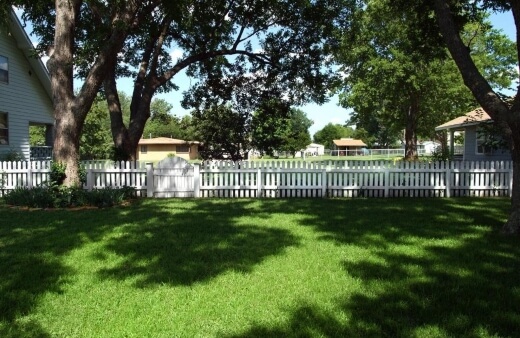
What are Lighting Problems?
A lack of light or too much light can cause lawn problems and lawn diseases. Some grass types in Australia do require certain amounts of sunlight to thrive and flourish.
A lack of light can cause moisture issues as evaporation is lessened or it can stunt the growth of your lawn where the process of photosynthesis would be affected.
Too much direct light can scorch your turf where prolonged exposure to heat can damage and shock your turf, leaving it unable to grow and thrive to its full potential.
How to Control Lighting Problems
It is recommended to plant turf varieties that will easily tolerate the lighting conditions in your landscape. There are many species of turf and grass that are more shade tolerant or hardier when it comes to exposure to harsher lighting.
Turf varieties such as Sir Walter Buffalo grass or ground cover species like bishop’s hat or sweet woodruff can be excellent turf alternatives for more challenging environments.
Be sure to chat to your local turf suppliers for professional advice on the best options for your lawn. Once you have chosen the turf you’ll use, be sure to check our guide on How to Lay Turf should you want to do it on your own.
2. Crabgrass Invading Your Garden
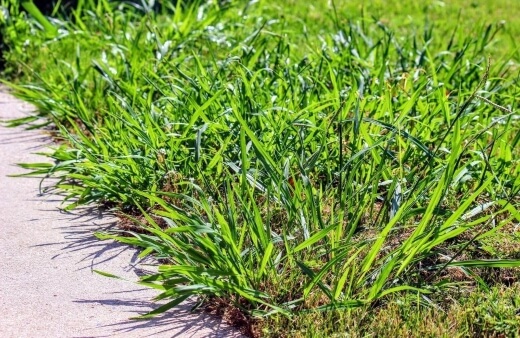
What is Crabgrass?
Due to its prolific seed production, crabgrass is one of the most invasive lawn weeds and when found in any Australian landscape, growers and homeowners should not hesitate in removing or killing it at the earliest opportunity.
You can identify crabgrass by its wide leaf blades and grass-like appearance. This grass produces tough stems with fingers of seed heads at the tips.
Crabgrass becomes most prominent and noticeable when the leaf blades outgrow the surrounding lawn causing them to become taller than the other turf which can lead to other lawn diseases.
How to Control Crabgrass
Yearly control of this weed is best done by mowing the lawn regularly as this will prevent mature seeds from being produced and stop unwanted spreading.
Mowing will encourage healthier, thicker growth in your turf that will help suppress these weeds and deter crabgrass infestations. If you have a big lawn, check out our buying guide on the best ride on mowers but if you think your lawn is not big enough to invest on one, consider automating your mowing schedule by getting a robot lawn mower instead.


Get Your Free Guide:
Master Growing Australian Natives eBook
A Must Have Complete Guide for Every Australian Garden
Get Your Free Guide:
Master Growing Australian Natives eBook
A Must Have Complete Guide for Every Australian Garden
Manually removing any crabgrass at the root with a sharp knife is another great way to prevent spread. Be sure not to spill any possible seeds on your lawn during removal.
In more severe cases, the use of crabgrass herbicides or corn gluten meal can help treat this weed effectively. Be sure to reinvigorate your lawn afterwards by applying fertiliser to the affected areas.
3. Patchy Grass

What Causes Patchy Grass?
One of the most common lawn problems is dead patches in your lawn and it is most likely caused by an issue with your soil and drainage. Certain types of grass and turf need specific soil conditions to grow best.
Most need well-draining, quality soil with balanced nutrient contents. If you have a leak in your garden or your turf is receiving too much water, this could also cause the grass to become patchy and wither over time.
How to Control Patchy Grass
If you are concerned about the quality of your soil, getting a soil test done could help you pinpoint particular problems in your lawn and aid you in prescribing the best possible treatment.
Try to also ensure you’re not overwatering your turf as this can cause other issues as well. The type of water you use can also affect the health of your lawn. Tap, rain, bore and greywater can all have certain advantages and disadvantages for your lawn.
If you want to know more about the types of water you can use for your plants, check out our guide on best water for plants in Australia.
4. Balding Grass
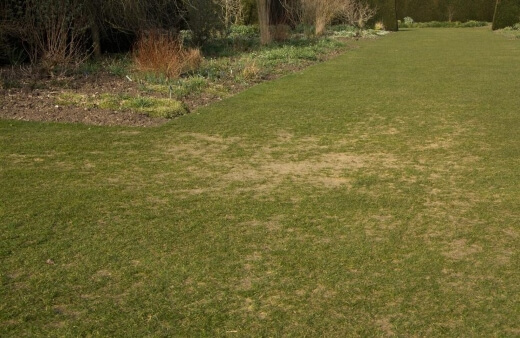
What is Balding Grass?
Balding grass appears as brown spots on your lawn that can not only look unattractive but they can also draw weeds and disease to the area.
These spots can be caused by a variety of factors from moisture problems to more serious lawn diseases like Fusarium Patch, Anthracnose, or Dollar Spot. Either way, these can be effectively treated to prevent lawn fungus spreading quite easily.
How to Control Balding Grass
One way to control browning spots on your lawn is to dig up and remove any damaged sections. You can then level your soil (a lawn leveller will help you do this more efficiently) and apply fresh soil, compost, and fertiliser to encourage new, healthy growth.
Make your own compost with the help of the best worm farms available online.
In more severe cases, a fungal issue is most likely the cause where the application of appropriate fungicides and solutions is the best way to treat the affected turf.
5. Lawn Grubs

What are Lawn Grubs?
These small, fat worms can do a surprising amount of damage to grassed areas where they can cause dead patches in the lawn, brown spots on your lawn grass and they can quickly become invasive.
These surface-dwelling caterpillars and grubs are types of common beetle larvae and can be easily identified. They are white, fat, and short worms with darker brown heads that usually curl into a C-shape.
They emerge and attack most in the spring when they feed on tender grassroots in a ravenous manner. It is important to stop their lifecycles as soon as possible by eliminating them.
Controlling Lawn Grubs
You should treat your lawn with an appropriate pesticide to get rid of these grubs in spring when they are newly hatched. Retreatment in autumn may be necessary in severe cases.
It is recommended to treat your lawn with the most natural and eco-friendly grub pesticides you can. A preventative application in spring can kill existing larvae and prevent further hatching throughout the season.
Combine your treatment with fertiliser and a good watering routine to ensure the pesticide reaches deep into the soil where the grubs are hiding. These grubs also tend to die out in dry conditions so watering your lawn infrequently but deeply can also help keep grubs away.
6. Lawn Black Spot

What is Black Spot?
Identifiable by black spots forming on the upper sides of your lawn’s leaves, this is one of the most unattractive lawn problems. Often caused by lawn diseases such as Leaf Spot, Pythium Blight, Leaf Smut, or Slime Mould, black spot can certainly sabotage the health and vigour of your lawn.
During the warmer months when the heat and humidity levels are elevated is when black spots can begin to form. The lawn's leaf blades will appear with reddish-black spots that create moulded masses on your lawn where the cobweb-like growths of fungi will be most apparent during humid, wet mornings and evenings.
Controlling Black Spot
The best treatment for this fungal disease is to also use appropriate fungicides. Fungicides with the common active ingredient Iprodione should work great.
7. Lawn Rust
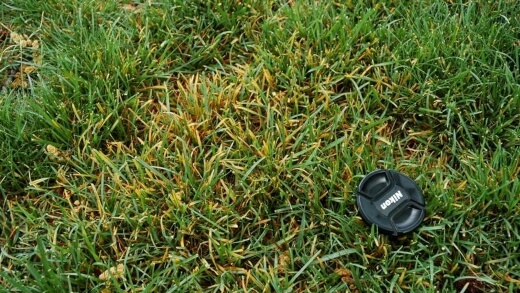
Source: content.ces.ncsu.edu
What is Lawn Rust?
Another very common culprit when looking at lawn problems is rust. This is a fungal disease that occurs on your lawn when growth is slowed or stunted.
Lawn rust usually appears in late summer to early autumn during periods of dry weather when the grass is likely low on nitrogen. This rust can weaken your turf and make it more susceptible to other diseases and problems.
You can identify lawn rust by pulling a couple of blades from your lawn, if you notice the blades are coated with orange-red to yellowish-brown dust or small spores, you most likely have a rust issue. The affected grass will also become thin and weak.
How to Fix Lawn Rust
The best solution here is to treat the affected turf with a fungicide with the common active ingredient Propiconazole for the best results. Lawn rust can also be prevented by proper lawn care and maintenance throughout the year.
8. Powdery Mildew
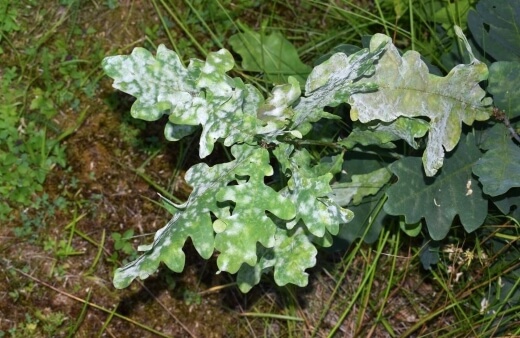
What is Powdery Mildew?
This is another fungal issue that if left untreated to spread, can quickly ruin the aesthetic of your garden. This mildew occurs most commonly on slow-growing turf and it thrives in shaded areas with cool, cloudy conditions.
It, therefore, favours the spring and autumn periods. Powdery mildew can be identified by grey to white cobweb-like growth on the upper surface of the leaf blades.
It can become denser with time to where the entire leaf surface of your lawn can appear dull white or pale green.
How to Control Powdery Mildew
It is recommended to seek advice from your local garden centres in severe cases but the use of a fungicide that contains Myclobutanil can inhibit the mildew’s development and reinvigorate your lawn.
9. Pythium/Drop Off

Source: turfpathology.ces.ncsu.edu
What is Pythium?
If you notice small patches of grass beginning to look water-soaked and turn dark purple, your turf may be infected. You will also notice a greasy or slimy texture forming on the leaf blades.
This is one of the lawn diseases that can cause your turf to shrivel and eventually die if left untreated. Commonly concentrated in low and wet areas in your landscape or along your lawn’s natural drainage courses, Pythium disease favours hot, humid, and wet conditions.
How to Deal with Pythium
This is another disease that can be effectively treated using fungicides and maintaining proper lawn care throughout the year. In severe cases, be sure to consult with your local specialists for more tailored solutions for your area.
Lawn Problems FAQ
How do you troubleshoot a lawn?
The most effective way to maintain a healthy, luscious lawn throughout the year is to practice good lawn care and maintenance habits.
- Fertilise regularly
- Aerate annually - See our review of the best lawn aerators here
- Don’t overwater or underwater
- Deep, infrequent waterings in the morning tend to be best for lawns
- Mow regularly
Is it better to dethatch or aerate?
It is recommended to first dethatch your lawn before aerating. By doing this you can first remove excess debris and encourage healthy root growth. Aerate if you have a problem with compaction in your soil.
How do I know if my lawn has fungus?
Common signs of fungal infection can include:
- Patches or rings that grow on your lawn
- Discoloured, thinning grass
- Mould-like or powdery growths forming on your leaf blades
Tips for Using Less Water and Chemicals on Your Lawn
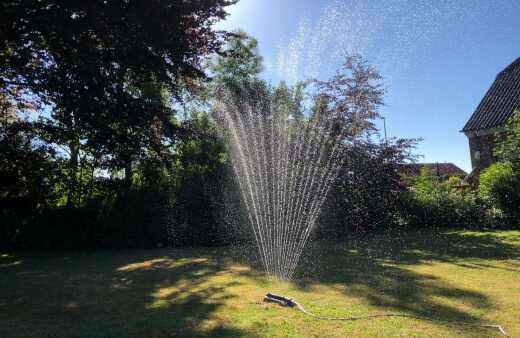
Lawn-care mistakes are common among well-meaning gardeners who water too frequently, confusing the number of watering sessions with getting the amount of moisture right.
In the long term, a light amount of water every day is bad for general lawn health. It also wastes your time and money.
Here are some ideas to help get your lawn care routine just right, so you use less water and won’t need to rely on chemicals:
1. Establish the Conditions
Your lawn’s most desirable watering routine depends on:
- Your lawn’s general health
- The local climate
- The drought-tolerance of your lawn variety
- Soil type and water absorption level
2. Water Deeply, Less Often
A common mistake made by busy gardeners is to give a small amount of water frequently. The problem is that shallow watering evaporates quickly and even a sun-soaked lawn won’t benefit from your efforts or your time, even if watered daily.
To nourish a lawn over time, its lowest, coolest roots must be soaked. Infrequent, deep watering reaches these for crucial growth and long-term health, ultimately equipping your lawn to survive long, dry spells.
The important exception is for newly-laid turf, which needs a frequent and deep watering regime for the short term, while it’s establishing.
3. Early Morning Watering
Avoid watering in the middle of the day, no matter how parched your lawn looks. Hot, dry weather will cause fast moisture-loss, effectively wasting your labour and your water.
Early morning is the most economical and beneficial time to water. Even at the end of a hot day, evening watering can lead to fungal diseases developing, due to the temperature drop after sunset.
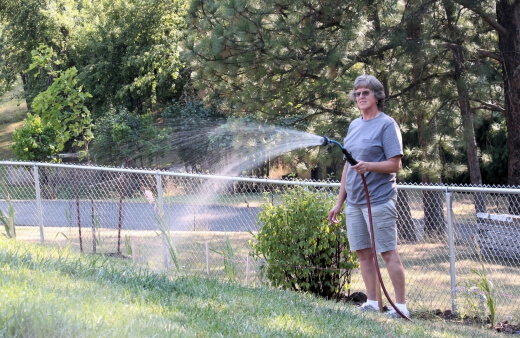
4. Test Water Depth
Making sure you’re watering the root-zone is important and the good news is, it’s easy to check. Professional landscapers use soil probes to measure moisture levels, as well as establishing temperature and nutrient levels.
At home, you can measure water penetration quickly and easily, just by using a 25cm screwdriver. The deeper your lawn’s moisture level, the easier it will be to push the screwdriver all the way in to your soil. If the dirt is too dry, it will be compacted.
You won’t get far with the screwdriver and you’ll know your soil needs longer watering. But remember, soil type is a key factor using this method, so if your soil is sandy, it will always be ‘soft’ and you may need to find another solution for testing water depth effectively.
5. Signs of a Dry Lawn
A lawn can be drying out, well beneath the surface without giving obvious signals, but it’s time to water deeply and to think about starting a watering routine when:
- Longer grass is wilting
- Grass colour is fading, turning yellow or brown
- There is no spring in your lawn as you walk on it
6. Fertilising to Prevent Chemical Use
After establishing the right deep-watering schedule for your lawn type and climate, remember the greenest lawns stay healthy and insect-free year-round when they are regularly fertilised.
Fertilising keeps lawn leaf-growth thick and healthy, which blocks access to the soil by weeds. With weed growth down, you won’t need to use chemicals on your lawn to treat them and the destructive pests they attract. (If the need do arises, refer to our roundup of the best weed killers available today.)
Fertiliser is easy to find at hardware stores and even large supermarkets. The task itself is simply a matter of sprinkling granules evenly across your lawn, according to instructions, during spring, summer and autumn.
Lawns are dormant during winter, when you can usually take a break from maintenance. Interested in learning more about excellent lawn alternatives in Australia? Be sure to have a look at our informative guide below:
Wrapping Up Our Lawn Problems Guide
Lawn diseases can certainly cause frustration and leave us with unappealing looking gardens but luckily, most of these issues are easily reversible and manageable.
Maintaining a proper lawn care and maintenance regime which includes adequate fertilising and watering with a good mowing routine should already give you the best shot at a healthy and thriving lawn.
Most of the other lawn problems like fungal diseases can easily be treated with suitable fungicides and other lawn care mixtures so be sure to chat to the professionals in your area if you need specialised product recommendations for your region and turf type.

Published on April 4, 2022 by Gary Clarke
Last Updated on September 20, 2025




